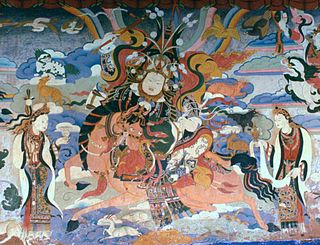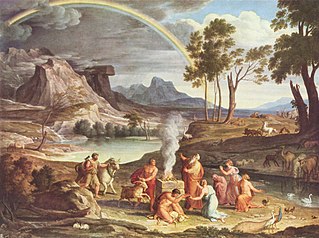
Efik mythology consists of a collection of myths narrated, sung or written down by the Efik people and passed down from generation to generation. Sources of Efik mythology include bardic poetry, art, songs, oral tradition and proverbs. Stories concerning Efik myths include creation myths, supernatural beings, mythical creatures, and warriors. Efik myths were initially told by Efik people and narrated under the moonlight. Myths, legends and historical stories are known in Efik as Mbụk while moonlight plays in Efik are known as Mbre Ọffiọñ.
Articles related to Mongolia include:

The culture of Mongolia has been shaped by the country's nomadic tradition and its position at the crossroads of various empires and civilizations. Mongolian culture is influenced by the cultures of the Mongolic, Turkic, and East Asian peoples, as well as by the country's geography and its history of political and economic interactions with other nations.

Tengri is the all-encompassing God of Heaven in the traditional Turkic, Yeniseian, Mongolic, and various other nomadic Altaic religious beliefs. Tengri is not considered a deity in the usual sense, but a personification of the universe. However, some qualities associated with Tengri as the judge and source of life, and being eternal and supreme, led European and Muslim writers to identify Tengri as a deity of Turkic and Mongolic peoples. According to Mongolian belief, Tengri's will (jayayan) may break its own usual laws and intervene by sending a chosen person to earth.

The Epic of King Gesar, spelled Geser or Kesar, is a work of epic literature of Tibet and greater Central Asia. The epic originally developed around 200 BCE or 300 BCE and about 600 CE. Following this, folk balladeers continued to pass on the story orally; this enriched the plot and embellished the language. The story reached its final form and height of popularity in the early 12th Century.

The rainbow has been a favorite component of mythology throughout history among many cultures around the world. Abrahamic traditions see it as a covenant with God to preserve the world from a second flood. Whether as a bridge to the heavens, messenger, archer's bow, or serpent, the rainbow has served as a symbol for millennia. There are myriad beliefs in a complex diversity with several repeated themes.

Erlik, Erlig, Erlik Khan, Erleg or Yerleg is the god of death and the underworld, sometimes referred to as Tamag (hell) in Turkic mythology. Er means Earth, in the depths of which Erlik lives in. From the underworld, Erlik brings forth death, plague and evil spirits to torment humans and take their souls into his realm. Since Tengrism is not based on a written corpus but encompasses the experienced spiritual life of Turkic people, there are no unanimous beliefs among all Turkic people. Erlik has already been mentioned in the Orkhon writings and shows a consistent pattern as the lord of the underworld among Turkic belief systems.

Turkic mythology refers to myths and legends told by the Turkic people. It features Tengrist and Shamanist strata of belief along with many other social and cultural constructs related to the nomadic and warrior way of life of Turkic and Mongol peoples in ancient times. Turkic mythology shares numerous points in common with Mongol mythology. Turkic mythology has also been influenced by other local Asiatic and Eurasian mythologies. For example, in Tatar mythology elements of Finnic and Indo-European mythologies co-exist. Beings from Tatar mythology include Äbädä, Alara, Şüräle, Şekä, Pitsen, Tulpar, and Zilant.

Tengrism is a religion originating in the Eurasian steppes, based on shamanism and animism. It generally involves the titular sky god Tengri, who is not considered a deity in the usual sense but a personification of the universe. According to some scholars, adherents of Tengrism view the purpose of life to be in harmony with the universe.
Üliger, tale is the general term given to tales and popular myths of the Mongols of north-east Asia. They are an important part of the oral traditions among the Buryats and other Siberian tribes, and among other functions, were used to orally transmit Buddhist birth stories. The tales are significant in Mongolian literature, given its long-standing tradition of passing stories on by word of mouth.

Tibetan mythology refers to the traditional as well as the religious stories that have been passed down by the Tibetan people. Tibetan mythology consists mainly of national mythology stemming from the Tibetan culture as well as religious mythology from both Tibetan Buddhism and Bön Religion. These myths are often passed down orally, through rituals or through traditional art like sculptures or cave paintings. They also feature a variety of different creatures ranging from gods to spirits to monsters play a significant role in Tibetan mythology with some of these myths have broken into mainstream Western media, with the most notable one being the Abominable Snowman – the Yeti.

Shambhala Training is a secular approach to meditation and a new religious movement developed by Tibetan Buddhist teacher Chögyam Trungpa Rinpoche and his students. It is based on what Trungpa calls Shambhala Vision, which sees enlightened society as not purely mythical, but as realizable by people of all faiths through practices of mindfulness/awareness, non-aggression, and sacred outlook.

The Mongol mythology is the traditional religion of the Mongols.
Segeen Sebdeg, the 3rd of the 55 tenger of the western skies, is the Buryat god of winter, and "is married to Ugan Sesen ... ". Their daughter Sesegen Nogoon married Zasa Mergen Baatar.
Zasa Mergen Baatar, in Buryat mythology, is the tornado-god riding a brown hawk-horse.

Mongolian literature is literature written in Mongolia and/or in the Mongolian language. It was greatly influenced by and evolved from its nomadic oral storytelling traditions, and it originated in the 13th century. The "three peaks" of Mongol literature, The Secret History of the Mongols, Epic of King Gesar and Epic of Jangar, all reflect the age-long tradition of heroic epics on the Eurasian Steppe. Mongol literature has also been a reflection of the society of the given time, its level of political, economic and social development as well as leading intellectual trends.

Mongolian shamanism, more broadly called the Mongolian folk religion, or occasionally Tengerism, refers to the animistic and shamanic ethnic religion that has been practiced in Mongolia and its surrounding areas at least since the age of recorded history. In the earliest known stages it was intricately tied to all other aspects of social life and to the tribal organization of Mongolian society. Along the way, it has become influenced by and mingled with Buddhism. During the socialist years of the twentieth century, it was heavily repressed, but has since made a comeback.

Epic poetry, or tuuli in Mongolian, is an important genre of Mongol oral literature, with features reminiscent of Germanic alliterative verse. The two most well-known epics are the Jangar and the Geser. These tuuli are commonly sung with instruments such as the Morin khuur and the Tovshuur (lute). Most epics deal with topics of the history of the Mongols, their ideal worlds and heroes, and the acquisition of new lands. Epics are performed mostly as celebrations or during important events. Mongol epic poetry has, as of 2009, been on the UNESCO List of Intangible Cultural Heritage in Need of Urgent Safeguarding.
Lower mythology is a sphere of mythological representations relating to characters who have no divine status, demons and spirits, as opposed to higher gods and the official cult. This opposition is particularly pronounced in world religions.
The Rich Khan Badma is a Buryat folktale, first collected by Buryat ethnographer and folklorist Matvei N. Khangalov. The tale is related to the theme of the calumniated wife and classified in the Aarne-Thompson-Uther Index as type ATU 707, "The Three Golden Children". Similar tales are found among other Mongolic peoples, sharing some of its motifs.